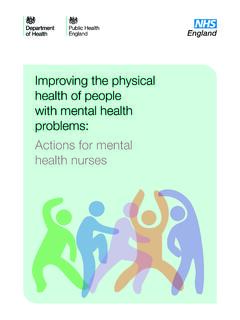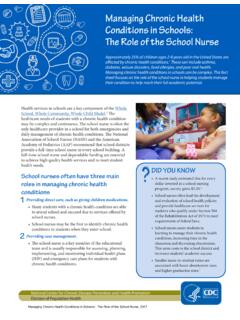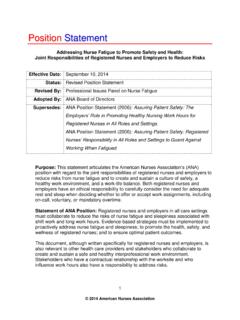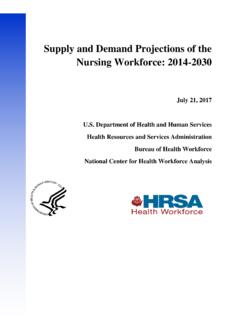Transcription of Sepsis Guidance for Health Professionals and School Nurses
1 Sepsis in Children Information for Health visitors and School Nurses Sepsis in Children: Information for Health visitors and School Nurses 2 About Public Health England Public Health England exists to protect and improve the nation s Health and wellbeing, and reduce Health inequalities. We do this through world-class science, knowledge and intelligence, advocacy, partnerships and the delivery of specialist public Health services. We are an executive agency of the Department of Health , and are a distinct delivery organisation with operational autonomy to advise and support government, local authorities and the NHS in a professionally independent manner.
2 Public Health England 133-155 Waterloo Road Wellington House London SE1 8UG Tel: 020 7654 8000 Twitter: @PHE_uk Facebook: Prepared by: Wendy Nicholson For queries relating to this document, please contact: Crown copyright 2017 You may re-use this information (excluding logos) free of charge in any format or medium, under the terms of the Open Government Licence To view this licence, visit OGL or email Where we have identified any third party copyright information you will need to obtain permission from the copyright holders concerned.
3 Published September 2017 Review date: March 2020 PHE publications PHE supports the UN gateway number: 201356 Sustainable Development Goals Sepsis in Children: Information for Health visitors and School Nurses 3 Contents Purpose of Guidance 4 What is Sepsis ? 4 Supporting parents 6 Resources for Health visitors and School Nurses 7 References and further information 8 Acknowledgements 10 Sepsis in Children: Information for Health visitors and School Nurses 4 Purpose of this guide Health visitors and School Nurses as public Health Nurses are leaders of the Healthy Child Programme: Pregnancy and the first five years of life and Healthy Child Programme: 5 to 19 years old (HCP).
4 They are often the primary Health contact point for parents and carers of children aged between 0-19 years. They, together with other Health Professionals , have a key role in providing advice or support for parents to allay fears or concerns about Sepsis . This short guide sets out what Health visitors and School Nurses need to know about Sepsis ; and is to designed to raise awareness of Sepsis locally amongst Health visitors and School Nurses and their teams. Parents often have regular contact and an ongoing relationship with Health visitors and School Nurses ; as such they may be the first point of contact for parents who have a concern.
5 Services provided by Health visitors and School Nurses are not intended to provide a first line treatment or diagnostic service for acutely unwell children, however, when an unwell child attends their service, the practitioner must have the knowledge to support parents to make a decision about the most appropriate course of action and signpost them to the appropriate help based on the child s presenting symptoms. Health visitors and School Nurses should therefore be aware of the clinical signs and symptoms of Sepsis in children and of relevant national guidelines.
6 They need to have clarity on actions that need to be taken and be clear about the advice for parents (NICE CG160, 2013). Understanding Sepsis What is Sepsis ? Sepsis is a rare but serious medical condition that results from the body s overwhelming response to an infection. Sepsis can occur in anyone at any time and from any type of infection affecting any part of the body. Without quick and timely treatment, Sepsis can lead to septic shock, multi-organ failure and death. Causes of Sepsis Sepsis is most often caused by bacterial, viral or fungal infections; sometimes the cause of Sepsis is never identified.
7 Sepsis in Children: Information for Health visitors and School Nurses 5 Children with pneumonia, urinary tract infections, meningitis and severe skin infections can rapidly deteriorate and develop Sepsis . It is important to recognise and act quickly on the symptoms of Sepsis in order to reduce morbidity and mortality. What are the symptoms of Sepsis ? Initial symptoms of Sepsis are often non-specific and may include fever, cough, sore throat, vomiting and diarrhoea. As the illness progresses, any combination of the following signs and symptoms may develop: shivering, fever or feeling very cold extreme pain or discomfort clammy or sweaty skin confusion or disorientation shortness of breath high heart rate Early symptoms of Sepsis often resemble a viral illness.
8 This makes Sepsis difficult to diagnose (Journal of Family Health Care, December 2016). However, if a child develops any of the following red flag symptoms, then parents, carers and healthcare Professionals must take immediate action: has mottled, blueish or pale skin is lethargic or difficult to wake is abnormally cold is breathing very fast has a rash that doesn t fade when you press it has a fit or convulsion Infants and children are often challenging to assess, as they will compensate physically for a long period until they reach a point where they are overwhelmed and deteriorate rapidly.
9 Sepsis in children is more common in those under 1 year of age, including: pre-term infants (less than 37 weeks) infants where there was a prolonged rupture of membranes during labour (more than 24 hours before delivery) infants born to mothers who had fever during labour (more than 38 C) children with recent trauma or injury or invasive procedure (within the last 6 weeks), children who have impaired immunity due to illness or drugs (for example, steroids or receiving chemotherapy) Sepsis in Children: Information for Health visitors and School Nurses 6 children with indwelling lines/catheters, or any breach of skin integrity (for example, cuts, burns, blisters or skin infections) children who are not fully immunised according to the nationally recommended schedule For more detailed information on Sepsis in children, including symptoms and signs, as well as early clinical management, please refer to the NICE Guideline [NG51]: Sepsis : recognition, diagnosis and early management.
10 Supporting parents Health visitors and School Nurses are a trusted and valued workforce delivering the Healthy Child Programme; they are ideally placed in the community to work with families promoting awareness, helping parents to recognise early signs of illness and providing advice, including swift referral to appropriate services. Health visitors and School Nurses need to ensure parents know how to respond to illness in children. They should: advise parents/carers to watch their child carefully when their child is unwell.
















